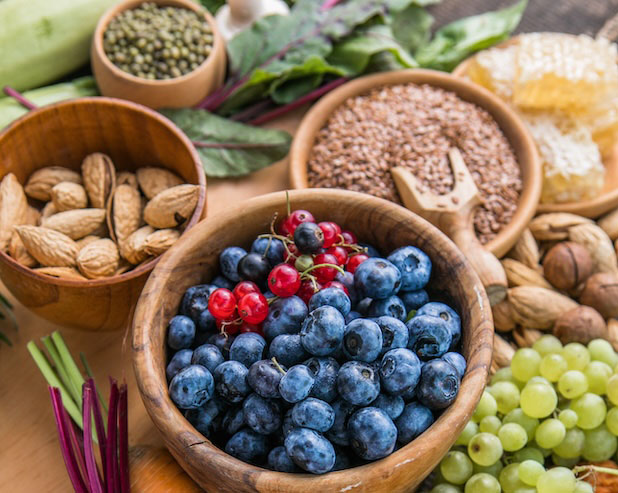vi·ta·min
/ˈvīdəmən/
noun
plural noun: vitamins
any of a group of organic compounds which are essential for normal growth and nutrition and are required in small quantities in the diet because they cannot be synthesized by the body.

Such is the definition of those compounds that are critical to our body’s function. They carry out a large range of normal functions. These compounds are organic substances that are generally classified as either fat-soluble or water-soluble. Fat-soluble vitamins (vitamin A, vitamin D, vitamin E, and vitamin K) dissolve in fat and tend to accumulate in the body. Water-soluble vitamins (vitamin C and the B-complex vitamins, such as vitamin B6, vitamin B12, and folate) must dissolve in water before they can be absorbed by the body, and therefore cannot be stored. Any water-soluble vitamin unused by the body is primarily lost through urine.
Vitamins and their precise requirements have been controversial since their discovery in the late 1800s and early 1900s. It was the combined efforts of epidemiologists, physicians, chemists, and physiologists that led to our modern-day understanding of vitamins and minerals. After years of observation, experiments, and trial and error, they were able to distinguish that some diseases were not caused by infections or toxins—a common belief at the time—but by vitamin deficiencies. Chemists worked to identify a vitamin’s chemical structure so it could be replicated. Soon after, researchers determined specific amounts of vitamins needed to avoid diseases of deficiency.
So, what are these specific amounts needed to be consumed daily? And what foods are natural providers?
Here are the answers:
Vitamin A: Women – 700 micrograms (2,333 IU); Men – 900 micrograms (3,000 IU)
Thiamin (vitamin B1): Women – 1.1 milligrams; Men – 1.2 milligrams
Riboflavin (vitamin B2): Women – 1.1 milligrams; Men – 1.3 milligrams
Niacin (vitamin B3; nicotinic acid): Women – 14 milligrams; Men – 16 milligrams
Pantothenic Acid (vitamin B5): Women – 5 milligrams; Men – 5 milligrams*
Vitamin B6 (pyridoxal, pyridoxine, pyridoxamine): Women Ages 19-50 – 1.3 milligrams; Ages 51+ – 1.5 milligrams; Men Ages 19-50 – 1.3 milligrams; Ages 51+ – 1.7 milligrams
Biotin (vitamin B7): Women and Men – 30 micrograms
Folate (Folic acid; vitamin B9): Women and Men – 400 micrograms
Vitamin B12: Women and Men – 2.4 micrograms
Vitamin C: Women – 75 milligrams; Men – 90 milligrams
Vitamin D: Women Ages 19-50 – 15 micrograms (600 IU); Ages 51-70 – 15 micrograms (600 IU); Ages 71+ – 20 micrograms (800 IU); Men Ages 19-50 – 15 micrograms (600 IU); Ages 51-70 – 15 micrograms (600 IU); Ages 71+ – 20 micrograms (800 IU)
Vitamin E (alpha-tocopherol): Women and Men – 15 milligrams
Vitamin K (phylloquinone, menadione): Women – 90 micrograms; Men – 120 micrograms
Although supplements are a good way to make up for a vitamin deficiency, it is very important to consult a physician before starting a supplement therapy. While a deficiency is bad for your health, an overdose is dangerous. For example, too much Vitamin D can cause Hypercalcemia, which is a condition in which the calcium level in your blood is above normal. Too much calcium in your blood can weaken your bones, create kidney stones, and interfere with how your heart and brain work. Also, each body processes differently and needs vary.

The best way to reach the recommended daily amount of vitamin intake is to, well, eat it. How? Following, are foods rich in these vitamins:
Vitamin A: Leafy Green Vegetables, Orange and Yellow Vegetables (Carrots, Sweet Potatoes, Pumpkin, Winter and Summer Squashes), Tomatoes, Red Bell Pepper, Cantaloupe, Mango, Beef Liver, Fish Oils, Milk, and Eggs.
Thiamine: Pork, Fish, Beans and Lentils, Green Peas, Enriched Cereals, Breads, Noodles and Rice,, Sunflower Seeds, and Yogurt.
Riboflavin: Dairy Milk, Yogurt, Cheese, Eggs, Lean Beef and Pork, Organ Meats (Beef Liver), Chicken Breast, and Salmon.
Niacin: Beef, Beef Liver, Pork, Poultry, Fish, Brown Rice, Enriched Cereals, Breads and Noodles, Nuts and Seeds, Legumes, and Bananas.
Pantothenic Acid: Beef, Poultry, Seafood and Organ Meats, Eggs and Milk, Vegetables such as Mushrooms (especially Shiitakes), Avocados, Potatoes and Broccoli, Whole Grains, Peanuts, Sunflower Seeds, and Chickpeas.
Vitamin B6: Beef, Tuna, Salmon, Poultry, Chickpeas, Dark Leafy Greens, Bananas, Papayas, Oranges, and Cantaloupe.
Biotin: Egg Yolks, Salmon, Sweet Potatoes, Organ Meats, Avocados, Legumes, Almonds, and Mushrooms.
Folate: Dark Green Leafy Vegetables, Asparagus, Brussels Sprouts, Broccoli, Beans, Peanuts, Sunflower Seeds, Fresh Fruits, Whole Grains, and Liver.
Vitamin B12: Clams, Liver, Fortified Cereal, Trout, Salmon, Tuna (canned), Beef, Nonfat Plain Greek Yogurt, Low-fat Milk, Ham, Eggs, and Chicken Breast
Vitamin C: Citrus Fruits, Tomatoes and Tomato Juice, Potatoes, Red and Green Peppers, Kiwifruit, Broccoli, Strawberries, Brussels Sprouts, and Cantaloupe.
Vitamin D: Dairy Products, Fatty Fish, Cod Liver Oil, Canned Tuna, Egg Yolks, and Mushrooms.
Vitamin K: Kale (cooked), Mustard Greens (cooked), Swiss Chard, Collard Greens (cooked), Spinach (raw), Broccoli, Brussels Sprouts, Beef Liver, Pork Chops and Chicken, Green Beans, Prunes, Kiwi, Hard Cheeses, Avocado, and Green Peas.
And those are the As, Bs, and Cs of vitamins!
(Source: Harvard Medical School)



